Comprehensive Report: JAMES Project Development and Evaluation
VerifiedAdded on 2020/02/24
|21
|3386
|35
Report
AI Summary
The JAMES project aimed to develop a smart card application for Mercedes Benz and other automotive service facilities. This report analyzes the project's management plan, including its objectives, risks, and technical processes. The project utilized Java architecture to create a running system on smart cards that interact with automobiles and an external client/server environment. The report details the project's deliverables, which include a Software Project Management Plan, requirements analysis documents, system design documents, and object design documents. The project followed an Object-Oriented Modeling Technique, and its development was organized into teams, each responsible for specific tasks. The project involved risk management, staffing, and detailed schedules and budgets. The successful completion of the JAMES project enabled drivers of Mercedes Benz and other automotive service facilities to use prototypical service applications with the use of a smart card.
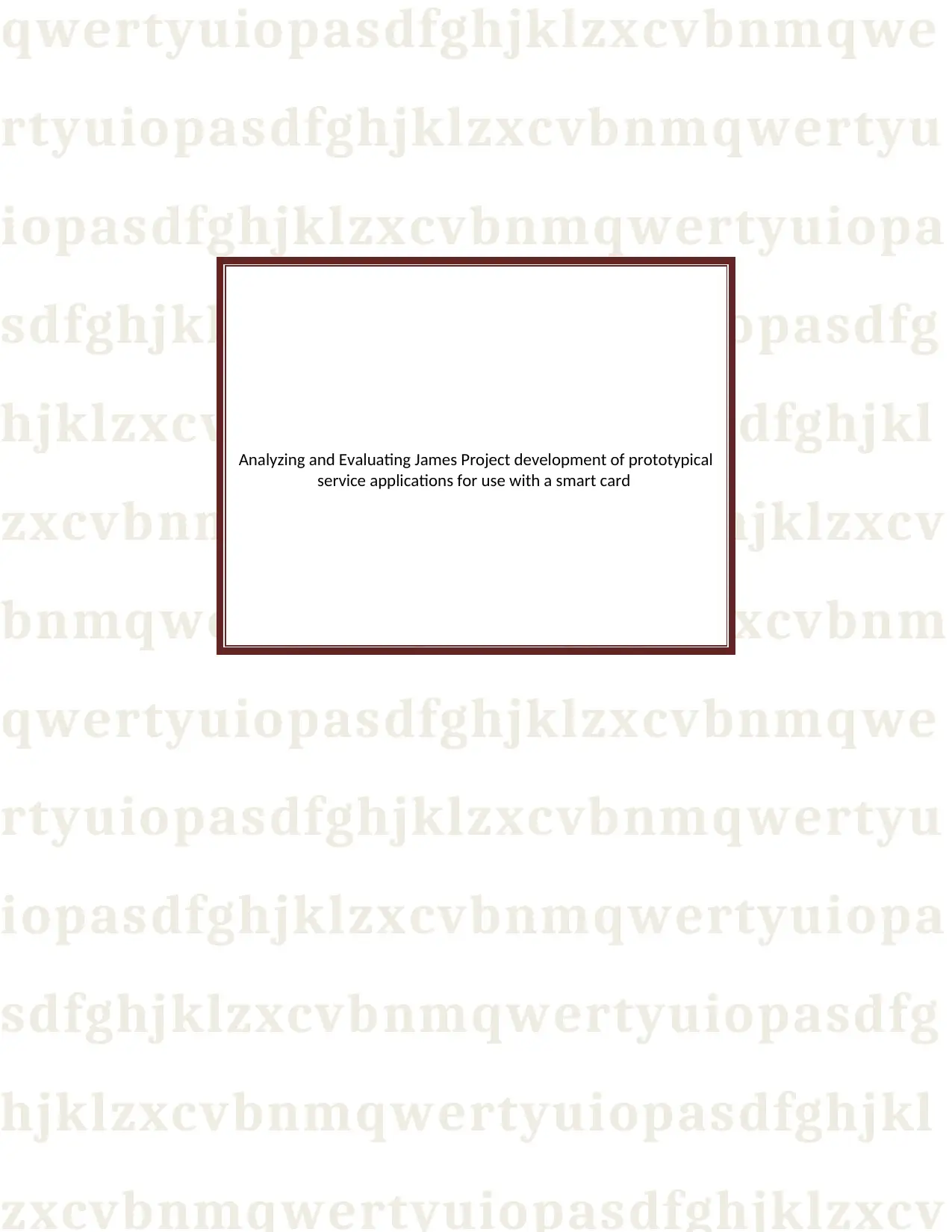
qwertyuiopasdfghjklzxcvbnmqwe
rtyuiopasdfghjklzxcvbnmqwertyu
iopasdfghjklzxcvbnmqwertyuiopa
sdfghjklzxcvbnmqwertyuiopasdfg
hjklzxcvbnmqwertyuiopasdfghjkl
zxcvbnmqwertyuiopasdfghjklzxcv
bnmqwertyuiopasdfghjklzxcvbnm
qwertyuiopasdfghjklzxcvbnmqwe
rtyuiopasdfghjklzxcvbnmqwertyu
iopasdfghjklzxcvbnmqwertyuiopa
sdfghjklzxcvbnmqwertyuiopasdfg
hjklzxcvbnmqwertyuiopasdfghjkl
zxcvbnmqwertyuiopasdfghjklzxcv
Analyzing and Evaluating James Project development of prototypical
service applications for use with a smart card
rtyuiopasdfghjklzxcvbnmqwertyu
iopasdfghjklzxcvbnmqwertyuiopa
sdfghjklzxcvbnmqwertyuiopasdfg
hjklzxcvbnmqwertyuiopasdfghjkl
zxcvbnmqwertyuiopasdfghjklzxcv
bnmqwertyuiopasdfghjklzxcvbnm
qwertyuiopasdfghjklzxcvbnmqwe
rtyuiopasdfghjklzxcvbnmqwertyu
iopasdfghjklzxcvbnmqwertyuiopa
sdfghjklzxcvbnmqwertyuiopasdfg
hjklzxcvbnmqwertyuiopasdfghjkl
zxcvbnmqwertyuiopasdfghjklzxcv
Analyzing and Evaluating James Project development of prototypical
service applications for use with a smart card
Paraphrase This Document
Need a fresh take? Get an instant paraphrase of this document with our AI Paraphraser
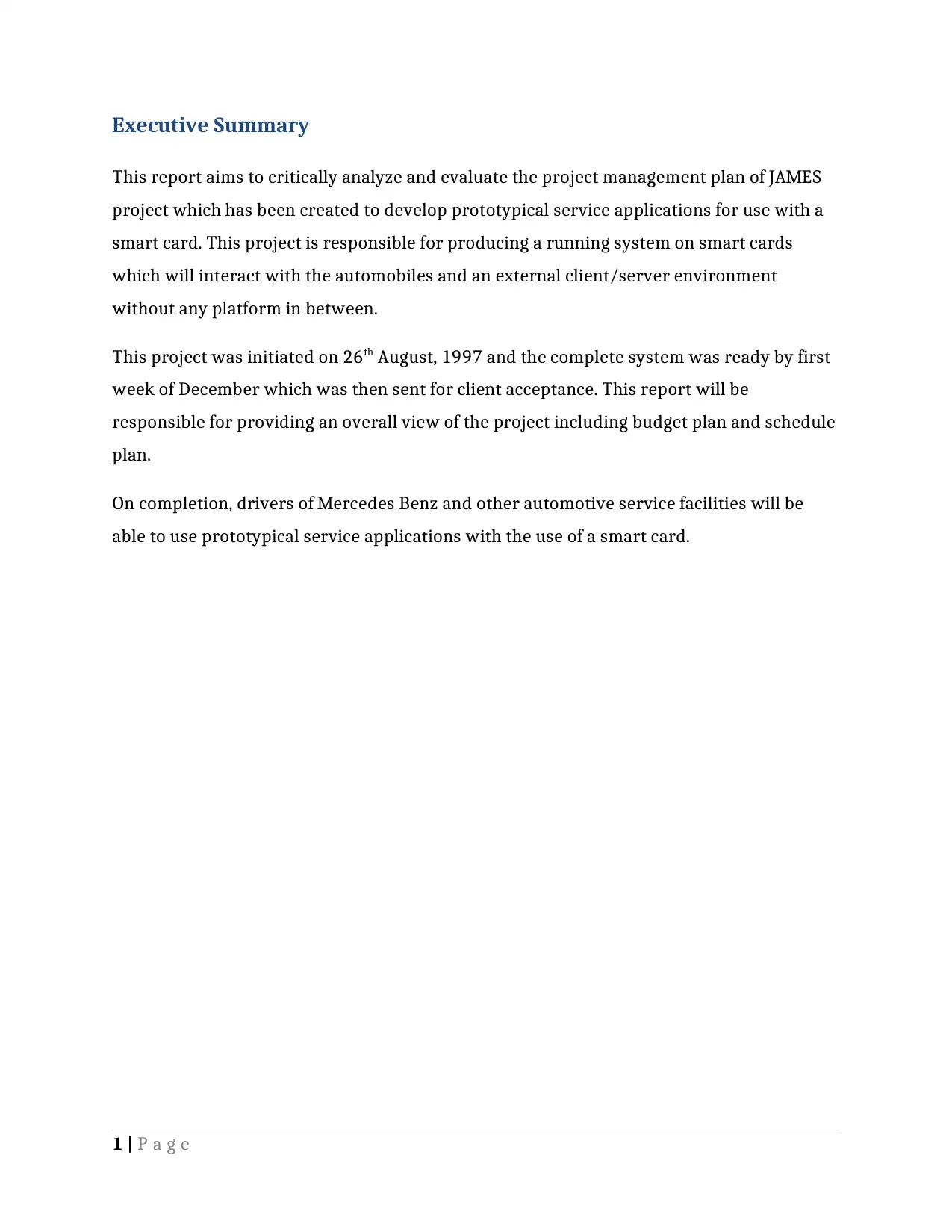
Executive Summary
This report aims to critically analyze and evaluate the project management plan of JAMES
project which has been created to develop prototypical service applications for use with a
smart card. This project is responsible for producing a running system on smart cards
which will interact with the automobiles and an external client/server environment
without any platform in between.
This project was initiated on 26th August, 1997 and the complete system was ready by first
week of December which was then sent for client acceptance. This report will be
responsible for providing an overall view of the project including budget plan and schedule
plan.
On completion, drivers of Mercedes Benz and other automotive service facilities will be
able to use prototypical service applications with the use of a smart card.
1 | P a g e
This report aims to critically analyze and evaluate the project management plan of JAMES
project which has been created to develop prototypical service applications for use with a
smart card. This project is responsible for producing a running system on smart cards
which will interact with the automobiles and an external client/server environment
without any platform in between.
This project was initiated on 26th August, 1997 and the complete system was ready by first
week of December which was then sent for client acceptance. This report will be
responsible for providing an overall view of the project including budget plan and schedule
plan.
On completion, drivers of Mercedes Benz and other automotive service facilities will be
able to use prototypical service applications with the use of a smart card.
1 | P a g e
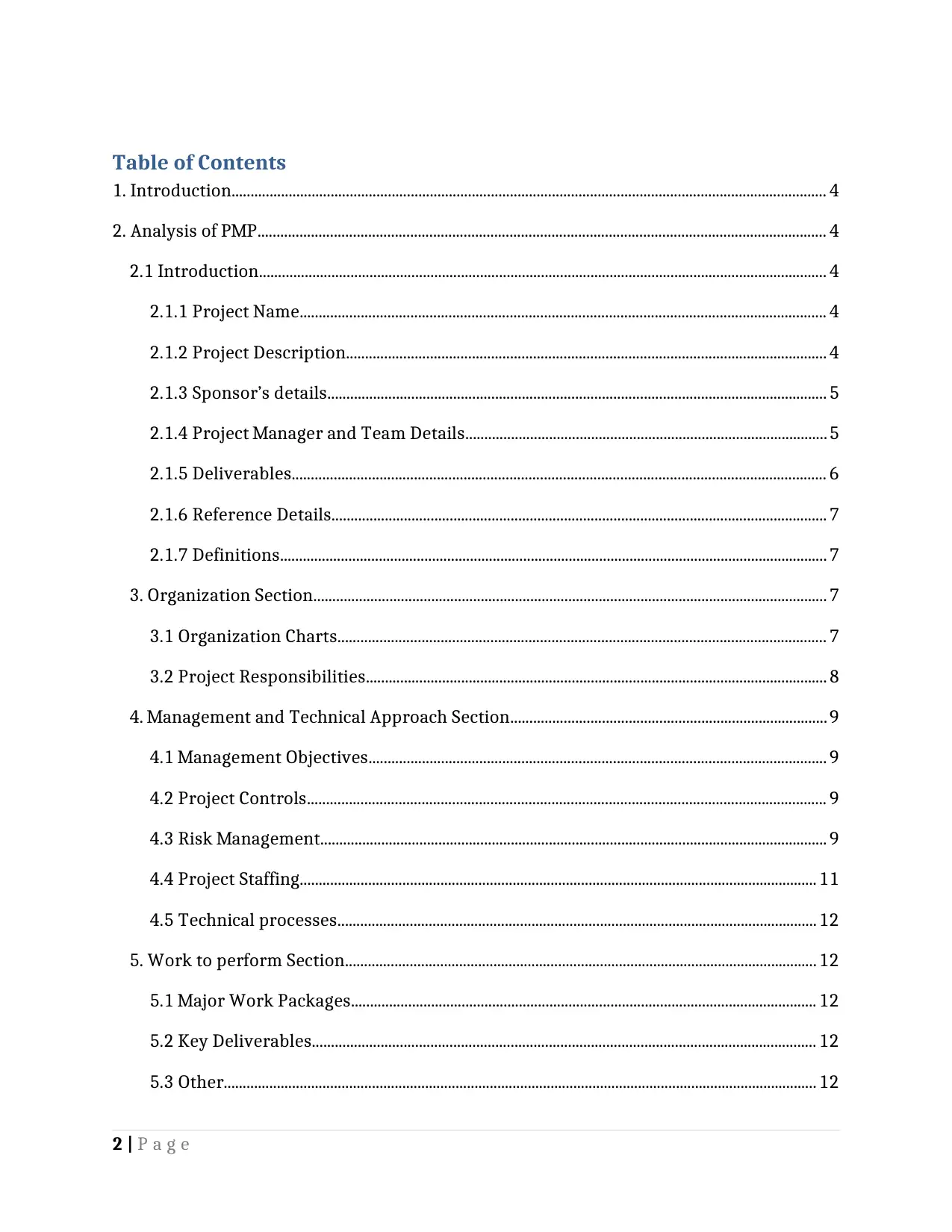
Table of Contents
1. Introduction............................................................................................................................................................ 4
2. Analysis of PMP..................................................................................................................................................... 4
2.1 Introduction..................................................................................................................................................... 4
2.1.1 Project Name.......................................................................................................................................... 4
2.1.2 Project Description.............................................................................................................................. 4
2.1.3 Sponsor’s details................................................................................................................................... 5
2.1.4 Project Manager and Team Details...............................................................................................5
2.1.5 Deliverables............................................................................................................................................ 6
2.1.6 Reference Details.................................................................................................................................. 7
2.1.7 Definitions................................................................................................................................................ 7
3. Organization Section....................................................................................................................................... 7
3.1 Organization Charts................................................................................................................................ 7
3.2 Project Responsibilities......................................................................................................................... 8
4. Management and Technical Approach Section...................................................................................9
4.1 Management Objectives........................................................................................................................ 9
4.2 Project Controls........................................................................................................................................ 9
4.3 Risk Management..................................................................................................................................... 9
4.4 Project Staffing........................................................................................................................................ 11
4.5 Technical processes..............................................................................................................................12
5. Work to perform Section............................................................................................................................12
5.1 Major Work Packages.......................................................................................................................... 12
5.2 Key Deliverables.................................................................................................................................... 12
5.3 Other............................................................................................................................................................ 12
2 | P a g e
1. Introduction............................................................................................................................................................ 4
2. Analysis of PMP..................................................................................................................................................... 4
2.1 Introduction..................................................................................................................................................... 4
2.1.1 Project Name.......................................................................................................................................... 4
2.1.2 Project Description.............................................................................................................................. 4
2.1.3 Sponsor’s details................................................................................................................................... 5
2.1.4 Project Manager and Team Details...............................................................................................5
2.1.5 Deliverables............................................................................................................................................ 6
2.1.6 Reference Details.................................................................................................................................. 7
2.1.7 Definitions................................................................................................................................................ 7
3. Organization Section....................................................................................................................................... 7
3.1 Organization Charts................................................................................................................................ 7
3.2 Project Responsibilities......................................................................................................................... 8
4. Management and Technical Approach Section...................................................................................9
4.1 Management Objectives........................................................................................................................ 9
4.2 Project Controls........................................................................................................................................ 9
4.3 Risk Management..................................................................................................................................... 9
4.4 Project Staffing........................................................................................................................................ 11
4.5 Technical processes..............................................................................................................................12
5. Work to perform Section............................................................................................................................12
5.1 Major Work Packages.......................................................................................................................... 12
5.2 Key Deliverables.................................................................................................................................... 12
5.3 Other............................................................................................................................................................ 12
2 | P a g e
⊘ This is a preview!⊘
Do you want full access?
Subscribe today to unlock all pages.

Trusted by 1+ million students worldwide
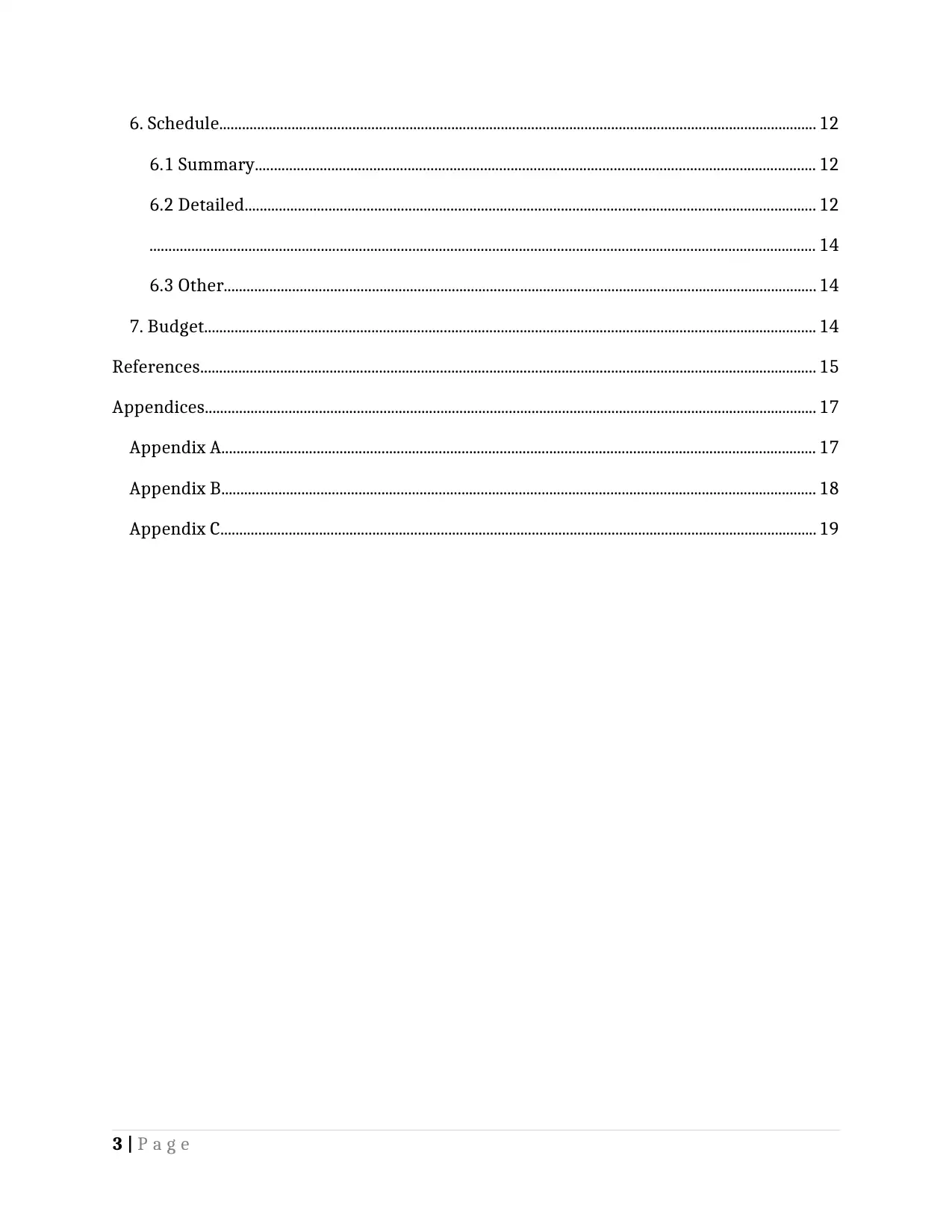
6. Schedule............................................................................................................................................................. 12
6.1 Summary................................................................................................................................................... 12
6.2 Detailed...................................................................................................................................................... 12
............................................................................................................................................................................... 14
6.3 Other............................................................................................................................................................ 14
7. Budget................................................................................................................................................................. 14
References.................................................................................................................................................................. 15
Appendices................................................................................................................................................................. 17
Appendix A............................................................................................................................................................ 17
Appendix B............................................................................................................................................................ 18
Appendix C............................................................................................................................................................. 19
3 | P a g e
6.1 Summary................................................................................................................................................... 12
6.2 Detailed...................................................................................................................................................... 12
............................................................................................................................................................................... 14
6.3 Other............................................................................................................................................................ 14
7. Budget................................................................................................................................................................. 14
References.................................................................................................................................................................. 15
Appendices................................................................................................................................................................. 17
Appendix A............................................................................................................................................................ 17
Appendix B............................................................................................................................................................ 18
Appendix C............................................................................................................................................................. 19
3 | P a g e
Paraphrase This Document
Need a fresh take? Get an instant paraphrase of this document with our AI Paraphraser
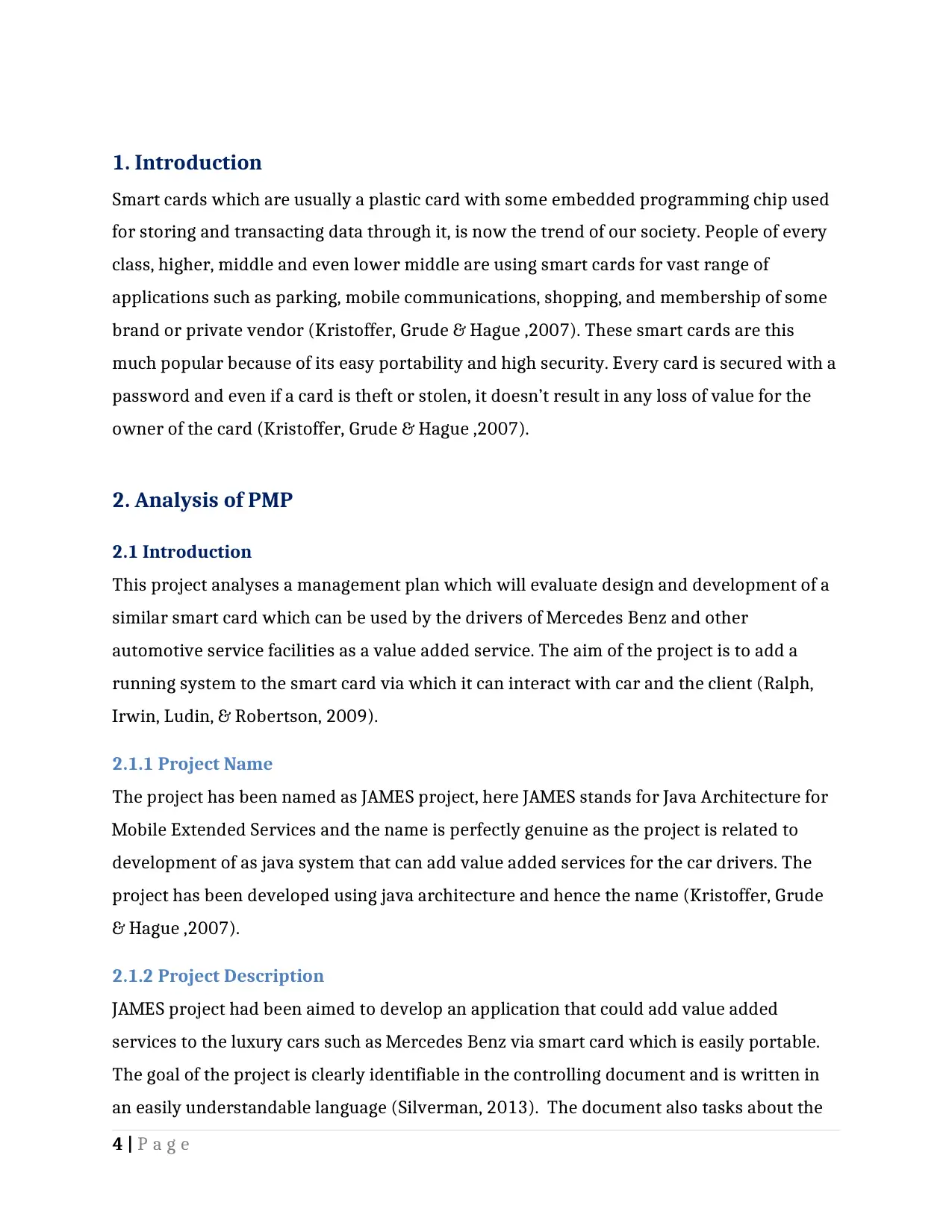
1. Introduction
Smart cards which are usually a plastic card with some embedded programming chip used
for storing and transacting data through it, is now the trend of our society. People of every
class, higher, middle and even lower middle are using smart cards for vast range of
applications such as parking, mobile communications, shopping, and membership of some
brand or private vendor (Kristoffer, Grude & Hague ,2007). These smart cards are this
much popular because of its easy portability and high security. Every card is secured with a
password and even if a card is theft or stolen, it doesn’t result in any loss of value for the
owner of the card (Kristoffer, Grude & Hague ,2007).
2. Analysis of PMP
2.1 Introduction
This project analyses a management plan which will evaluate design and development of a
similar smart card which can be used by the drivers of Mercedes Benz and other
automotive service facilities as a value added service. The aim of the project is to add a
running system to the smart card via which it can interact with car and the client (Ralph,
Irwin, Ludin, & Robertson, 2009).
2.1.1 Project Name
The project has been named as JAMES project, here JAMES stands for Java Architecture for
Mobile Extended Services and the name is perfectly genuine as the project is related to
development of as java system that can add value added services for the car drivers. The
project has been developed using java architecture and hence the name (Kristoffer, Grude
& Hague ,2007).
2.1.2 Project Description
JAMES project had been aimed to develop an application that could add value added
services to the luxury cars such as Mercedes Benz via smart card which is easily portable.
The goal of the project is clearly identifiable in the controlling document and is written in
an easily understandable language (Silverman, 2013). The document also tasks about the
4 | P a g e
Smart cards which are usually a plastic card with some embedded programming chip used
for storing and transacting data through it, is now the trend of our society. People of every
class, higher, middle and even lower middle are using smart cards for vast range of
applications such as parking, mobile communications, shopping, and membership of some
brand or private vendor (Kristoffer, Grude & Hague ,2007). These smart cards are this
much popular because of its easy portability and high security. Every card is secured with a
password and even if a card is theft or stolen, it doesn’t result in any loss of value for the
owner of the card (Kristoffer, Grude & Hague ,2007).
2. Analysis of PMP
2.1 Introduction
This project analyses a management plan which will evaluate design and development of a
similar smart card which can be used by the drivers of Mercedes Benz and other
automotive service facilities as a value added service. The aim of the project is to add a
running system to the smart card via which it can interact with car and the client (Ralph,
Irwin, Ludin, & Robertson, 2009).
2.1.1 Project Name
The project has been named as JAMES project, here JAMES stands for Java Architecture for
Mobile Extended Services and the name is perfectly genuine as the project is related to
development of as java system that can add value added services for the car drivers. The
project has been developed using java architecture and hence the name (Kristoffer, Grude
& Hague ,2007).
2.1.2 Project Description
JAMES project had been aimed to develop an application that could add value added
services to the luxury cars such as Mercedes Benz via smart card which is easily portable.
The goal of the project is clearly identifiable in the controlling document and is written in
an easily understandable language (Silverman, 2013). The document also tasks about the
4 | P a g e
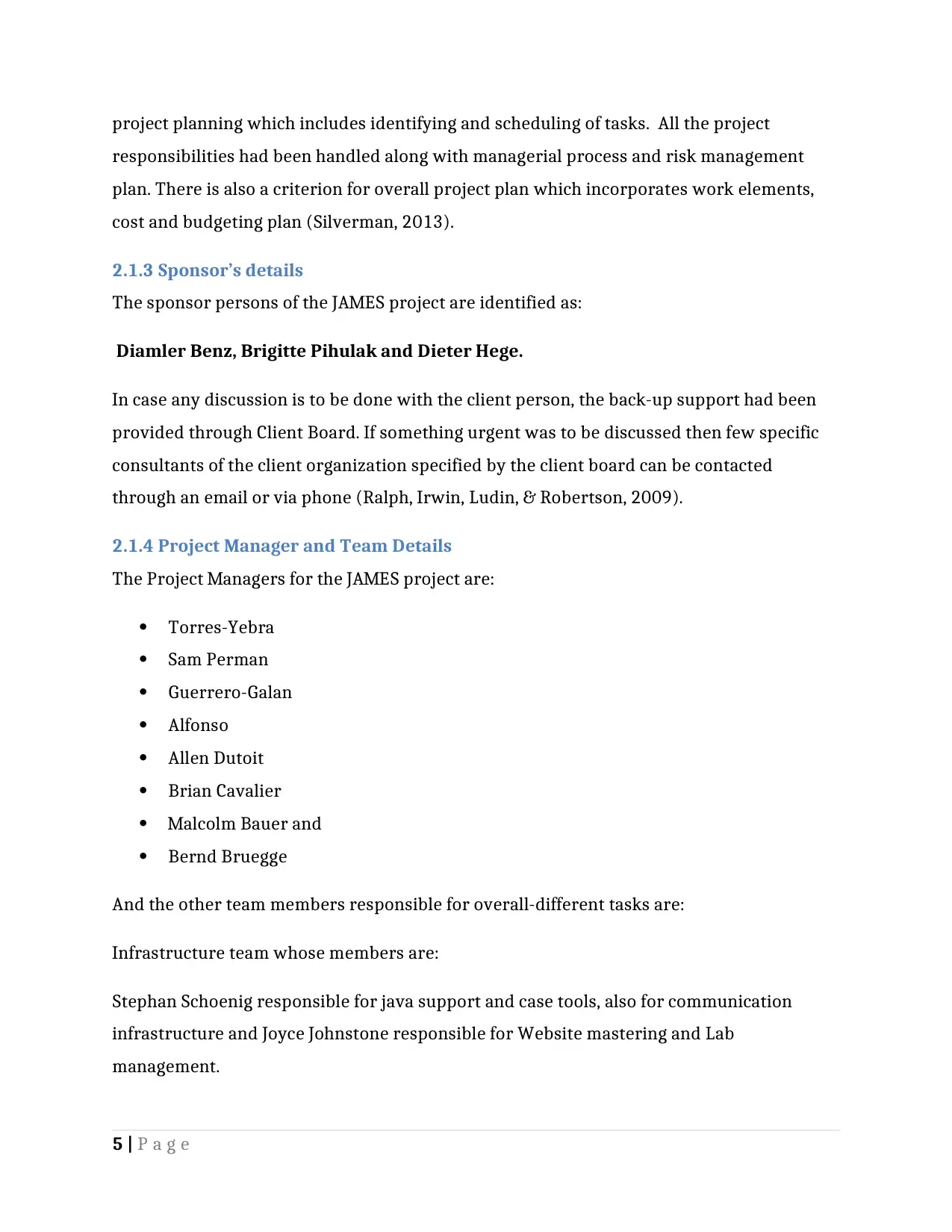
project planning which includes identifying and scheduling of tasks. All the project
responsibilities had been handled along with managerial process and risk management
plan. There is also a criterion for overall project plan which incorporates work elements,
cost and budgeting plan (Silverman, 2013).
2.1.3 Sponsor’s details
The sponsor persons of the JAMES project are identified as:
Diamler Benz, Brigitte Pihulak and Dieter Hege.
In case any discussion is to be done with the client person, the back-up support had been
provided through Client Board. If something urgent was to be discussed then few specific
consultants of the client organization specified by the client board can be contacted
through an email or via phone (Ralph, Irwin, Ludin, & Robertson, 2009).
2.1.4 Project Manager and Team Details
The Project Managers for the JAMES project are:
Torres-Yebra
Sam Perman
Guerrero-Galan
Alfonso
Allen Dutoit
Brian Cavalier
Malcolm Bauer and
Bernd Bruegge
And the other team members responsible for overall-different tasks are:
Infrastructure team whose members are:
Stephan Schoenig responsible for java support and case tools, also for communication
infrastructure and Joyce Johnstone responsible for Website mastering and Lab
management.
5 | P a g e
responsibilities had been handled along with managerial process and risk management
plan. There is also a criterion for overall project plan which incorporates work elements,
cost and budgeting plan (Silverman, 2013).
2.1.3 Sponsor’s details
The sponsor persons of the JAMES project are identified as:
Diamler Benz, Brigitte Pihulak and Dieter Hege.
In case any discussion is to be done with the client person, the back-up support had been
provided through Client Board. If something urgent was to be discussed then few specific
consultants of the client organization specified by the client board can be contacted
through an email or via phone (Ralph, Irwin, Ludin, & Robertson, 2009).
2.1.4 Project Manager and Team Details
The Project Managers for the JAMES project are:
Torres-Yebra
Sam Perman
Guerrero-Galan
Alfonso
Allen Dutoit
Brian Cavalier
Malcolm Bauer and
Bernd Bruegge
And the other team members responsible for overall-different tasks are:
Infrastructure team whose members are:
Stephan Schoenig responsible for java support and case tools, also for communication
infrastructure and Joyce Johnstone responsible for Website mastering and Lab
management.
5 | P a g e
⊘ This is a preview!⊘
Do you want full access?
Subscribe today to unlock all pages.

Trusted by 1+ million students worldwide
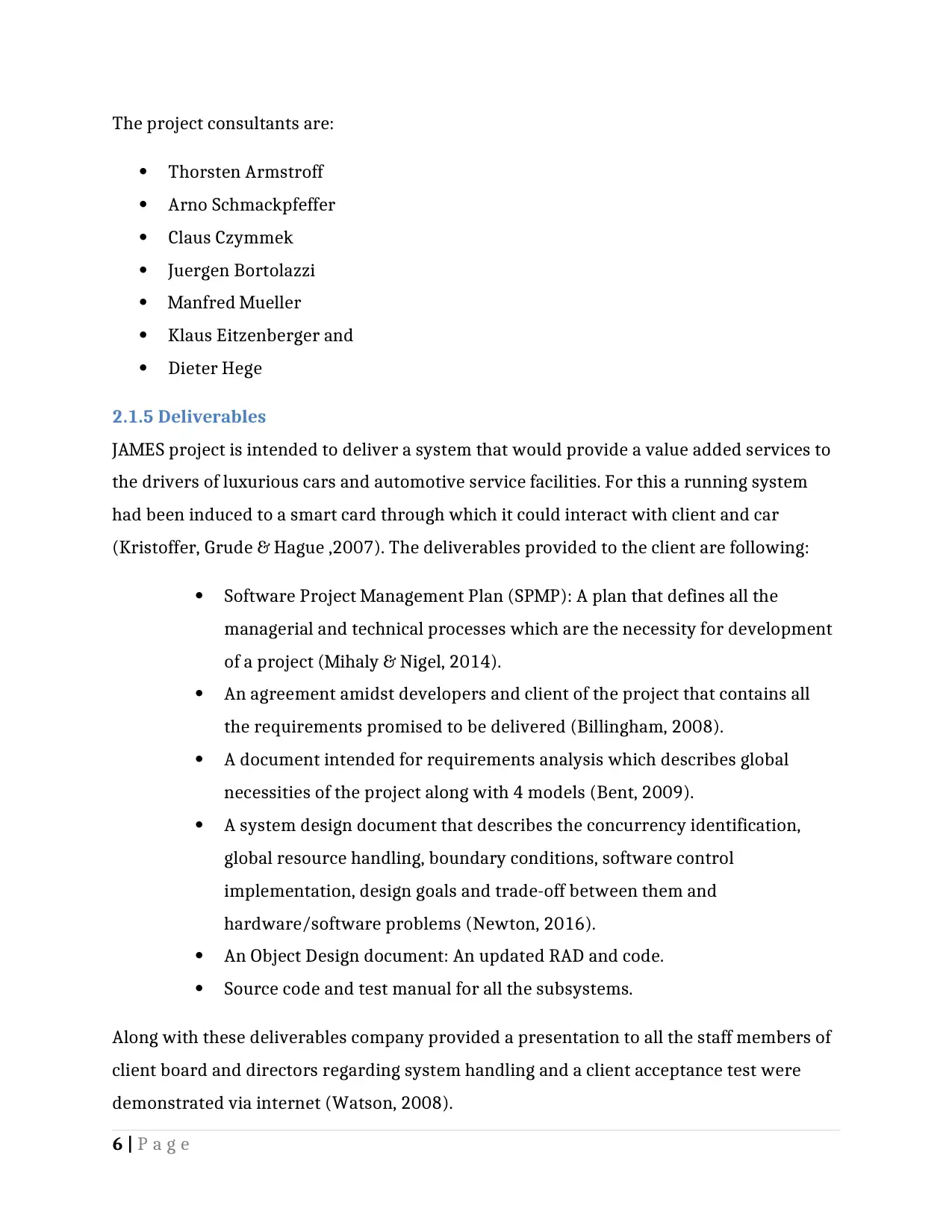
The project consultants are:
Thorsten Armstroff
Arno Schmackpfeffer
Claus Czymmek
Juergen Bortolazzi
Manfred Mueller
Klaus Eitzenberger and
Dieter Hege
2.1.5 Deliverables
JAMES project is intended to deliver a system that would provide a value added services to
the drivers of luxurious cars and automotive service facilities. For this a running system
had been induced to a smart card through which it could interact with client and car
(Kristoffer, Grude & Hague ,2007). The deliverables provided to the client are following:
Software Project Management Plan (SPMP): A plan that defines all the
managerial and technical processes which are the necessity for development
of a project (Mihaly & Nigel, 2014).
An agreement amidst developers and client of the project that contains all
the requirements promised to be delivered (Billingham, 2008).
A document intended for requirements analysis which describes global
necessities of the project along with 4 models (Bent, 2009).
A system design document that describes the concurrency identification,
global resource handling, boundary conditions, software control
implementation, design goals and trade-off between them and
hardware/software problems (Newton, 2016).
An Object Design document: An updated RAD and code.
Source code and test manual for all the subsystems.
Along with these deliverables company provided a presentation to all the staff members of
client board and directors regarding system handling and a client acceptance test were
demonstrated via internet (Watson, 2008).
6 | P a g e
Thorsten Armstroff
Arno Schmackpfeffer
Claus Czymmek
Juergen Bortolazzi
Manfred Mueller
Klaus Eitzenberger and
Dieter Hege
2.1.5 Deliverables
JAMES project is intended to deliver a system that would provide a value added services to
the drivers of luxurious cars and automotive service facilities. For this a running system
had been induced to a smart card through which it could interact with client and car
(Kristoffer, Grude & Hague ,2007). The deliverables provided to the client are following:
Software Project Management Plan (SPMP): A plan that defines all the
managerial and technical processes which are the necessity for development
of a project (Mihaly & Nigel, 2014).
An agreement amidst developers and client of the project that contains all
the requirements promised to be delivered (Billingham, 2008).
A document intended for requirements analysis which describes global
necessities of the project along with 4 models (Bent, 2009).
A system design document that describes the concurrency identification,
global resource handling, boundary conditions, software control
implementation, design goals and trade-off between them and
hardware/software problems (Newton, 2016).
An Object Design document: An updated RAD and code.
Source code and test manual for all the subsystems.
Along with these deliverables company provided a presentation to all the staff members of
client board and directors regarding system handling and a client acceptance test were
demonstrated via internet (Watson, 2008).
6 | P a g e
Paraphrase This Document
Need a fresh take? Get an instant paraphrase of this document with our AI Paraphraser
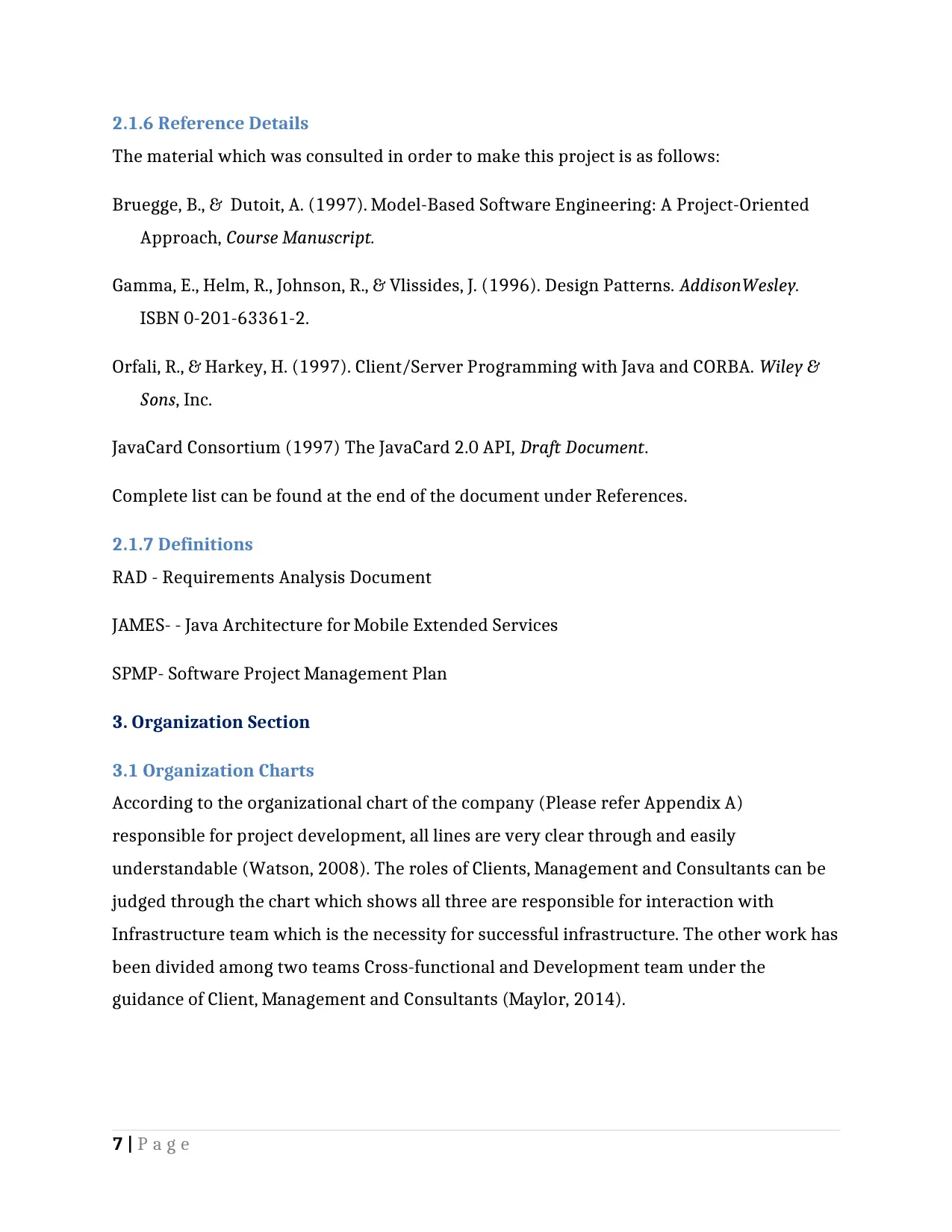
2.1.6 Reference Details
The material which was consulted in order to make this project is as follows:
Bruegge, B., & Dutoit, A. (1997). Model-Based Software Engineering: A Project-Oriented
Approach, Course Manuscript.
Gamma, E., Helm, R., Johnson, R., & Vlissides, J. (1996). Design Patterns. AddisonWesley.
ISBN 0-201-63361-2.
Orfali, R., & Harkey, H. (1997). Client/Server Programming with Java and CORBA. Wiley &
Sons, Inc.
JavaCard Consortium (1997) The JavaCard 2.0 API, Draft Document.
Complete list can be found at the end of the document under References.
2.1.7 Definitions
RAD - Requirements Analysis Document
JAMES- - Java Architecture for Mobile Extended Services
SPMP- Software Project Management Plan
3. Organization Section
3.1 Organization Charts
According to the organizational chart of the company (Please refer Appendix A)
responsible for project development, all lines are very clear through and easily
understandable (Watson, 2008). The roles of Clients, Management and Consultants can be
judged through the chart which shows all three are responsible for interaction with
Infrastructure team which is the necessity for successful infrastructure. The other work has
been divided among two teams Cross-functional and Development team under the
guidance of Client, Management and Consultants (Maylor, 2014).
7 | P a g e
The material which was consulted in order to make this project is as follows:
Bruegge, B., & Dutoit, A. (1997). Model-Based Software Engineering: A Project-Oriented
Approach, Course Manuscript.
Gamma, E., Helm, R., Johnson, R., & Vlissides, J. (1996). Design Patterns. AddisonWesley.
ISBN 0-201-63361-2.
Orfali, R., & Harkey, H. (1997). Client/Server Programming with Java and CORBA. Wiley &
Sons, Inc.
JavaCard Consortium (1997) The JavaCard 2.0 API, Draft Document.
Complete list can be found at the end of the document under References.
2.1.7 Definitions
RAD - Requirements Analysis Document
JAMES- - Java Architecture for Mobile Extended Services
SPMP- Software Project Management Plan
3. Organization Section
3.1 Organization Charts
According to the organizational chart of the company (Please refer Appendix A)
responsible for project development, all lines are very clear through and easily
understandable (Watson, 2008). The roles of Clients, Management and Consultants can be
judged through the chart which shows all three are responsible for interaction with
Infrastructure team which is the necessity for successful infrastructure. The other work has
been divided among two teams Cross-functional and Development team under the
guidance of Client, Management and Consultants (Maylor, 2014).
7 | P a g e
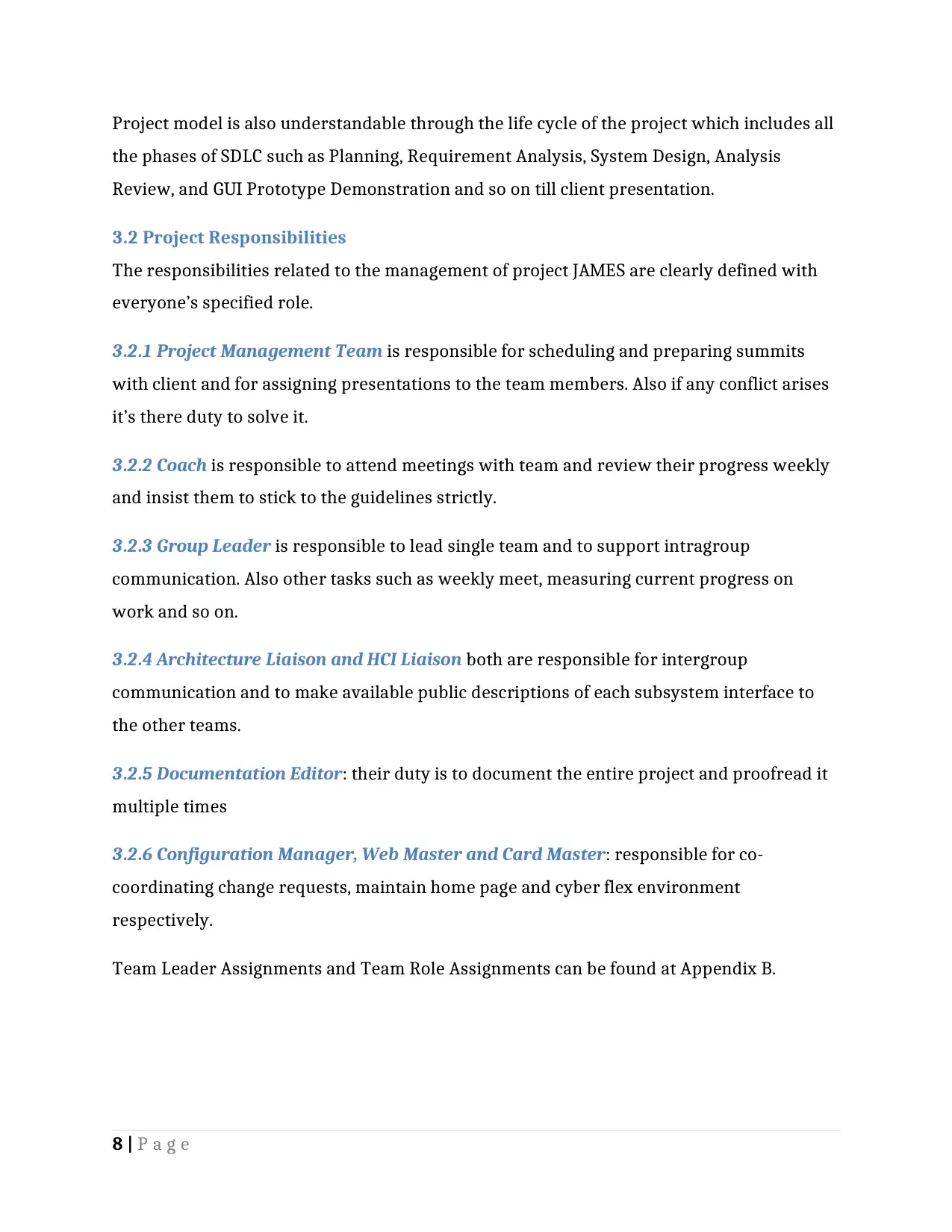
Project model is also understandable through the life cycle of the project which includes all
the phases of SDLC such as Planning, Requirement Analysis, System Design, Analysis
Review, and GUI Prototype Demonstration and so on till client presentation.
3.2 Project Responsibilities
The responsibilities related to the management of project JAMES are clearly defined with
everyone’s specified role.
3.2.1 Project Management Team is responsible for scheduling and preparing summits
with client and for assigning presentations to the team members. Also if any conflict arises
it’s there duty to solve it.
3.2.2 Coach is responsible to attend meetings with team and review their progress weekly
and insist them to stick to the guidelines strictly.
3.2.3 Group Leader is responsible to lead single team and to support intragroup
communication. Also other tasks such as weekly meet, measuring current progress on
work and so on.
3.2.4 Architecture Liaison and HCI Liaison both are responsible for intergroup
communication and to make available public descriptions of each subsystem interface to
the other teams.
3.2.5 Documentation Editor: their duty is to document the entire project and proofread it
multiple times
3.2.6 Configuration Manager, Web Master and Card Master: responsible for co-
coordinating change requests, maintain home page and cyber flex environment
respectively.
Team Leader Assignments and Team Role Assignments can be found at Appendix B.
8 | P a g e
the phases of SDLC such as Planning, Requirement Analysis, System Design, Analysis
Review, and GUI Prototype Demonstration and so on till client presentation.
3.2 Project Responsibilities
The responsibilities related to the management of project JAMES are clearly defined with
everyone’s specified role.
3.2.1 Project Management Team is responsible for scheduling and preparing summits
with client and for assigning presentations to the team members. Also if any conflict arises
it’s there duty to solve it.
3.2.2 Coach is responsible to attend meetings with team and review their progress weekly
and insist them to stick to the guidelines strictly.
3.2.3 Group Leader is responsible to lead single team and to support intragroup
communication. Also other tasks such as weekly meet, measuring current progress on
work and so on.
3.2.4 Architecture Liaison and HCI Liaison both are responsible for intergroup
communication and to make available public descriptions of each subsystem interface to
the other teams.
3.2.5 Documentation Editor: their duty is to document the entire project and proofread it
multiple times
3.2.6 Configuration Manager, Web Master and Card Master: responsible for co-
coordinating change requests, maintain home page and cyber flex environment
respectively.
Team Leader Assignments and Team Role Assignments can be found at Appendix B.
8 | P a g e
⊘ This is a preview!⊘
Do you want full access?
Subscribe today to unlock all pages.

Trusted by 1+ million students worldwide
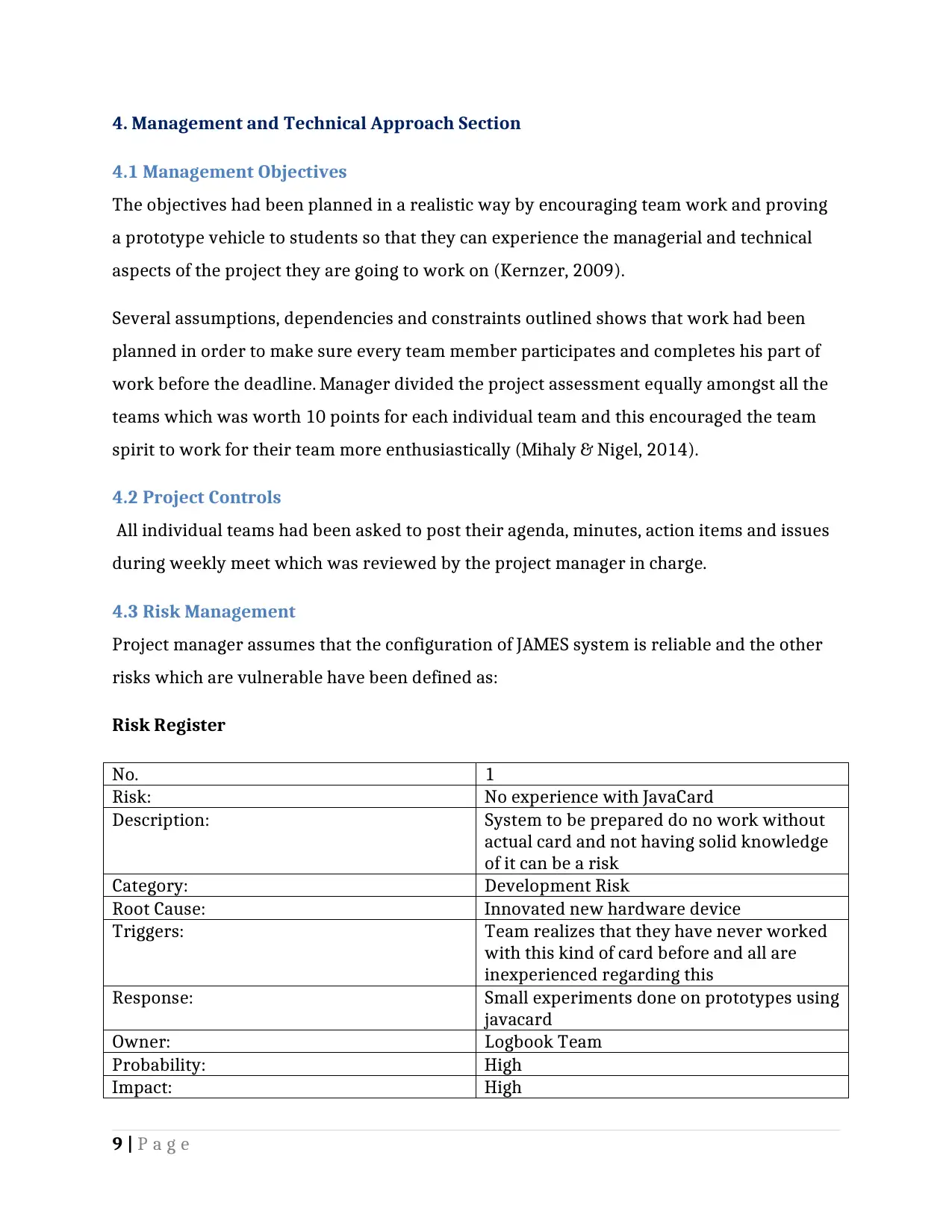
4. Management and Technical Approach Section
4.1 Management Objectives
The objectives had been planned in a realistic way by encouraging team work and proving
a prototype vehicle to students so that they can experience the managerial and technical
aspects of the project they are going to work on (Kernzer, 2009).
Several assumptions, dependencies and constraints outlined shows that work had been
planned in order to make sure every team member participates and completes his part of
work before the deadline. Manager divided the project assessment equally amongst all the
teams which was worth 10 points for each individual team and this encouraged the team
spirit to work for their team more enthusiastically (Mihaly & Nigel, 2014).
4.2 Project Controls
All individual teams had been asked to post their agenda, minutes, action items and issues
during weekly meet which was reviewed by the project manager in charge.
4.3 Risk Management
Project manager assumes that the configuration of JAMES system is reliable and the other
risks which are vulnerable have been defined as:
Risk Register
No. 1
Risk: No experience with JavaCard
Description: System to be prepared do no work without
actual card and not having solid knowledge
of it can be a risk
Category: Development Risk
Root Cause: Innovated new hardware device
Triggers: Team realizes that they have never worked
with this kind of card before and all are
inexperienced regarding this
Response: Small experiments done on prototypes using
javacard
Owner: Logbook Team
Probability: High
Impact: High
9 | P a g e
4.1 Management Objectives
The objectives had been planned in a realistic way by encouraging team work and proving
a prototype vehicle to students so that they can experience the managerial and technical
aspects of the project they are going to work on (Kernzer, 2009).
Several assumptions, dependencies and constraints outlined shows that work had been
planned in order to make sure every team member participates and completes his part of
work before the deadline. Manager divided the project assessment equally amongst all the
teams which was worth 10 points for each individual team and this encouraged the team
spirit to work for their team more enthusiastically (Mihaly & Nigel, 2014).
4.2 Project Controls
All individual teams had been asked to post their agenda, minutes, action items and issues
during weekly meet which was reviewed by the project manager in charge.
4.3 Risk Management
Project manager assumes that the configuration of JAMES system is reliable and the other
risks which are vulnerable have been defined as:
Risk Register
No. 1
Risk: No experience with JavaCard
Description: System to be prepared do no work without
actual card and not having solid knowledge
of it can be a risk
Category: Development Risk
Root Cause: Innovated new hardware device
Triggers: Team realizes that they have never worked
with this kind of card before and all are
inexperienced regarding this
Response: Small experiments done on prototypes using
javacard
Owner: Logbook Team
Probability: High
Impact: High
9 | P a g e
Paraphrase This Document
Need a fresh take? Get an instant paraphrase of this document with our AI Paraphraser
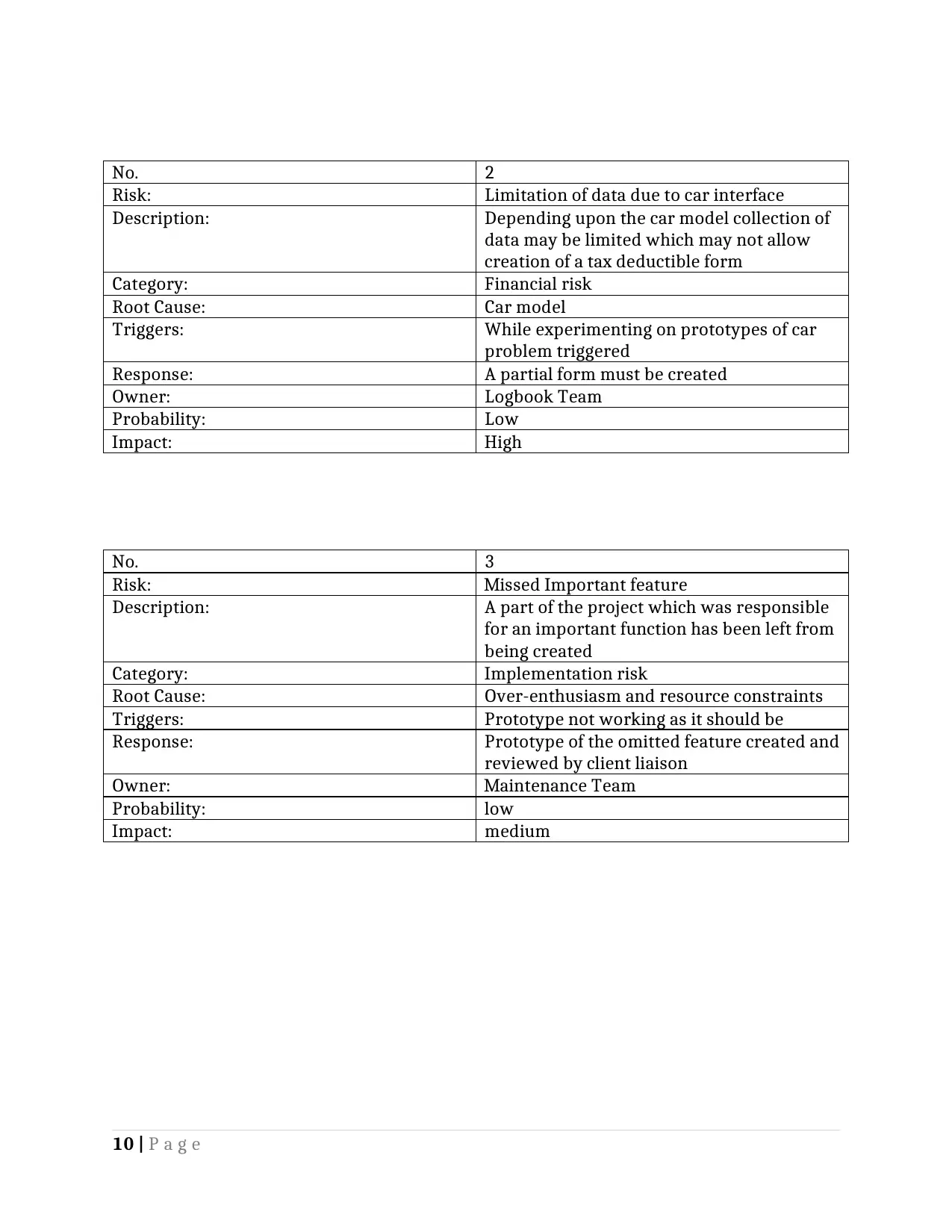
No. 2
Risk: Limitation of data due to car interface
Description: Depending upon the car model collection of
data may be limited which may not allow
creation of a tax deductible form
Category: Financial risk
Root Cause: Car model
Triggers: While experimenting on prototypes of car
problem triggered
Response: A partial form must be created
Owner: Logbook Team
Probability: Low
Impact: High
No. 3
Risk: Missed Important feature
Description: A part of the project which was responsible
for an important function has been left from
being created
Category: Implementation risk
Root Cause: Over-enthusiasm and resource constraints
Triggers: Prototype not working as it should be
Response: Prototype of the omitted feature created and
reviewed by client liaison
Owner: Maintenance Team
Probability: low
Impact: medium
10 | P a g e
Risk: Limitation of data due to car interface
Description: Depending upon the car model collection of
data may be limited which may not allow
creation of a tax deductible form
Category: Financial risk
Root Cause: Car model
Triggers: While experimenting on prototypes of car
problem triggered
Response: A partial form must be created
Owner: Logbook Team
Probability: Low
Impact: High
No. 3
Risk: Missed Important feature
Description: A part of the project which was responsible
for an important function has been left from
being created
Category: Implementation risk
Root Cause: Over-enthusiasm and resource constraints
Triggers: Prototype not working as it should be
Response: Prototype of the omitted feature created and
reviewed by client liaison
Owner: Maintenance Team
Probability: low
Impact: medium
10 | P a g e
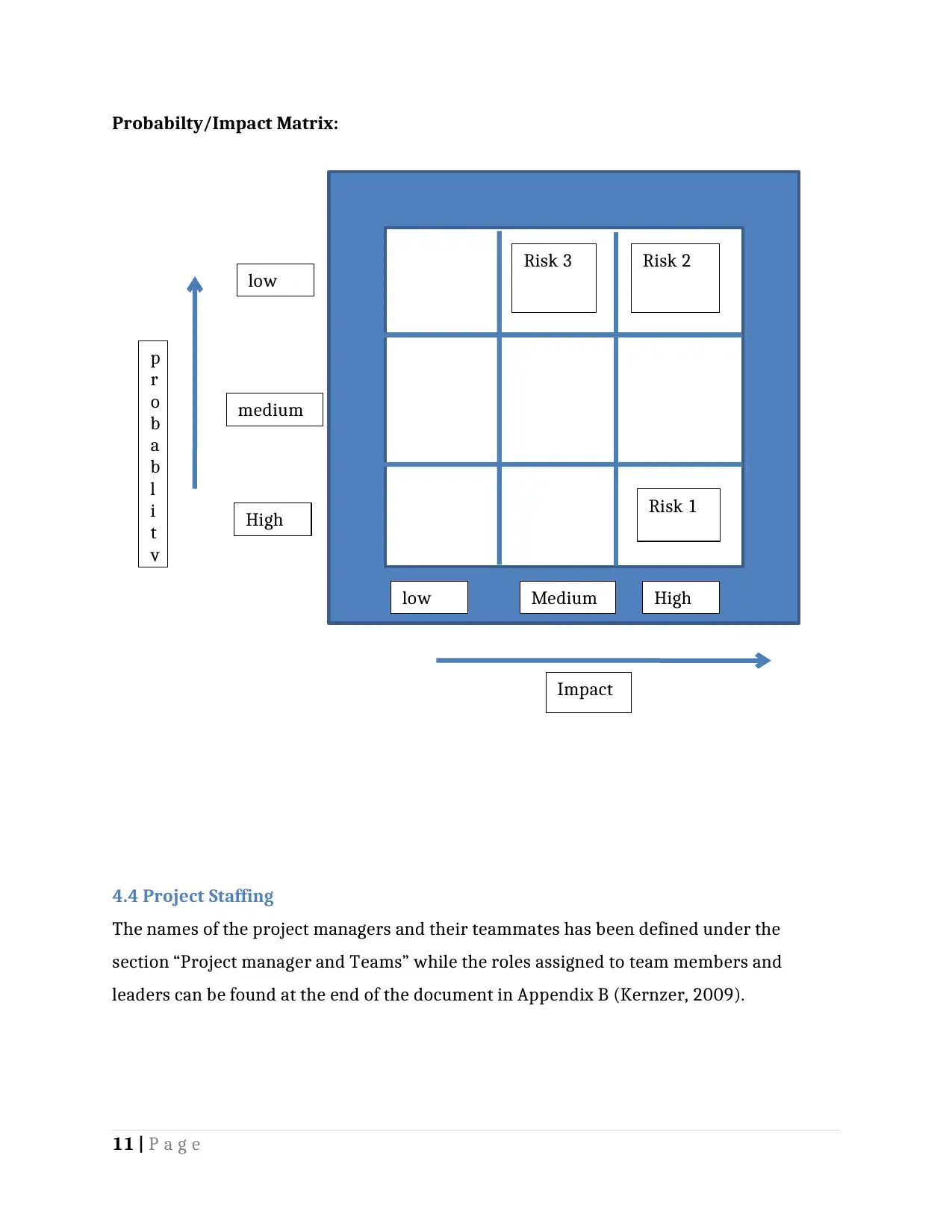
Probabilty/Impact Matrix:
4.4 Project Staffing
The names of the project managers and their teammates has been defined under the
section “Project manager and Teams” while the roles assigned to team members and
leaders can be found at the end of the document in Appendix B (Kernzer, 2009).
11 | P a g e
Risk 3 Risk 2
Risk 1
Impact
p
r
o
b
a
b
l
i
t
y
low Medium High
High
medium
low
4.4 Project Staffing
The names of the project managers and their teammates has been defined under the
section “Project manager and Teams” while the roles assigned to team members and
leaders can be found at the end of the document in Appendix B (Kernzer, 2009).
11 | P a g e
Risk 3 Risk 2
Risk 1
Impact
p
r
o
b
a
b
l
i
t
y
low Medium High
High
medium
low
⊘ This is a preview!⊘
Do you want full access?
Subscribe today to unlock all pages.

Trusted by 1+ million students worldwide
1 out of 21
Your All-in-One AI-Powered Toolkit for Academic Success.
+13062052269
info@desklib.com
Available 24*7 on WhatsApp / Email
![[object Object]](/_next/static/media/star-bottom.7253800d.svg)
Unlock your academic potential
Copyright © 2020–2025 A2Z Services. All Rights Reserved. Developed and managed by ZUCOL.

